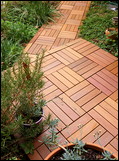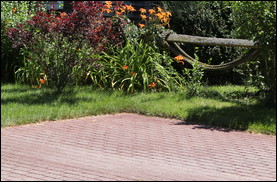 Materials like brick are not too reflective or too absorbent. |
The darker the color, the more heat it will absorb and the hotter it will become. White reflects the most heat and light — it is the coolest to touch. A blacktop driveway may get hot enough to fry eggs. Stone and water absorb heat slowly and stay warm in the evenings. They cool off overnight and then heat up again slowly in the morning. This principle is important for dry-arid desert areas, where the days are hot but the nights chill rapidly. Warm pavements near the house mitigate the cold evenings. Then they feel cool during the hot mornings. The same principle applies to passive solar-heating systems, which use the retained heat of the day.
When deciding on surface materials near the house, consider which is more important: (1) conservation of warmth, or (2) providing a cooling effect during the day.
If daytime cooling is more important, then lawns, ground covers or the like are the choice. Sometimes where lawn maintenance is an unwanted burden, people turn to paving. Too often, however, they end up with a hot spot instead of the cool, easy-care area they had bargained for. A house or a terrace surrounded with paving or driveways will absorb the heat that reflects from the paving. The area will be much warmer than it was before the paving.
In southern areas, more air conditioning is required to keep a house near paving comfortable. In cold climates, the reflected heat in winter from paving is a cost benefit. In addition a blacktop driveway is always preferred to concrete in the North, because the black absorbs heat during sunny days and also melts snow and ice faster.
Around solar-heated buildings, it is especially important that the ground be as warm and dry as possible, so paving is useful. Even brown or black plastic sheeting can be useful on the ground near buildings that might otherwise be damp and cold. The plastic can be covered with wood chips for a better appearance. These techniques are most useful on the southern sides of buildings, where sun warming can occur in winter. A protective shield of shrubs and trees is still preferred for the north side and any other exposure subject to heavy winter winds.
 Durable paving material should be set on a bed of leveled builder’s sand or stone dust. |
Paving Materials
Paving can be of various materials. There is costly but durable bluestone, brick or concrete. Crushed stone costs less and is attractive and useful, particularly if laid over a weed-retardant film or fabric. Stepping stones are useful where passage is needed. If they are level with a lawn, they can be mowed over without any time-consuming special trimming.
If durable paving materials are used, they should be properly set on a bed of leveled sharp builder’s sand or stone dust for permanence and to prevent heaving and settling. The most satisfactory material is bluestone. Slate is good but has a tendency to shale and split off in layers. Stone that splits and shales should not be used near swimming pools or anywhere people go barefoot.
Brick is another excellent material for paving. It is set in sand or stone as above. It has a pleasant texture and color, not too reflective nor too absorbent. Brick is good for temperate and tropical regions where a lighter color surface would be too reflective and a dark one would be too hot.
Preformed concrete paving blocks are attractive and inexpensive compared to bluestone and brick. Color can be added to the concrete mix. Some people actually enjoy making forms and pouring their own blocks. Ready-mix concrete makes this much easier than it used to be. Leaves or other objects can be pressed onto the surface of the moist concrete to make interesting designs.
Pressure-treated wood is useful for decks or walks but needs treatment with a wood preservative or stain every several years. Wood lasts about fifteen years. Wood rounds, or cross-section slices of big tree trunks, make inexpensive paving or stepping "stones," however, they are not permanent. The wood has a tendency to crack and check. Wood preservatives help some. The rounds, which are most attractive and interesting, may last from five to fifteen years. Women wearing high heels may trip in the spaces between the rounds.
 Wood chips are an inexpensive but temporary surface material solution. |
Where the absolute lowest cost is a requirement, a load of inexpensive wood chips from a local tree removal company will provide a pleasant surface for outdoor activities. Or when tree work is done on your property, have the wood chips spread around instead of paying for disposal. Being economical, however, can also have its drawbacks. Wood chips are not permanent. Also there is a tendency for the chips to wash away if drainage is not correct and they can cling to shoes.
A more serious drawback is that wood rounds and chips are flammable. Furthermore they often provide a happy home for termites and carpenter ants and so should be keep away from buildings, where they might cause havoc.
Yet they do provide a rustic, comfortable surface underfoot. If there is cedar, pine or fir shavings in the chips, the resins will become volatile on warm days and give off a most agreeable woodland scent. Dry chips warm up in the sun on chilly days, but because of their porous quality, they never become too hot. In the shade they stay damp and cool. They conserve ground moisture and impart a good spongy texture to the soil beneath. Wood chips are a perfect choice under trees where sitting space is wanted but paving would damage the tree roots.
Bark mulch is similar to wood chips except that it is made of evergreen bark. It looks better. It does not decay as fast as plain wood chips and usually does not bring or harbor insects. It also costs a little more, but, depending on where it’s used, it may be worth it.
 |
See more examples of pavers and outdoor surface materials in the Paving Inspiration Gallery
Credit: www.mothersgarden.net




























